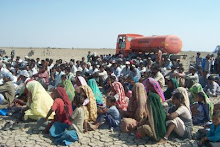Counterview.net: Ahmedabad: Saturday, April 05, 2014.
After a lapse
of three years, the Gujarat government has once again revived its plan to begin
eviction of the salt-pan workers, or agariyas of the Little Rann of Kutch.
Earlier, the notice was served on them in April 2011 (read HERE). The latest
notice served on the agariyas reads, "You have been asked to submit
documentary proof regarding salt making activity in the Little Rann of Kutch.”
Quoting the Wild Life Protection Act, 1972, amended in 2002, the notice, given
to thousands of agariyas, says that any activity in the sanctuary area of the
Little Rann of Kutch “is termed prohibited and is liable to punishment from
three to seven years of imprisonment, plus Rs 25,000 penalty.”
Giving the
agariyas just about a week to provide the proof that they have been leased land
in the Little Rann of Kutch to carry out salt producing activity, the notice
says, “You are hereby given notice that if you have any documentary evidence
submit it within seven days, or else you have to vacate the Rann of Kutch along
with all your equipment of salt making.” The notice has been issued by the
range forest officer, Wild Ass Sanctuary, Little Rann of Kutch.
The Agariya
Hit Rakshak Manch (AHRM), which represents the salt-pan workers, in a statement
has said, “On behalf of 12,000 to 15,000 agariya families, AHRM had made a
representation to Gujarat’s tribal commissioner to initiate the process of
recognizing agariyas’ customary community user rights over the Little Rann of
Kutch as per the Forest Rights Act. The representation is still pending.”
According to ARHM, the agariyas should be recognized as tribals, in the same
way as the tribals of the eastern tribal belt of Gujarat.
It has added,
“The fact to be noted is that, the Little Rann of Kutch is near 5,000 sq km of
un-surveyed piece of land, and was recently given survey number zero. The
Gujarat government too does not have any land records for the same. It is
surprising that the state government is asking the agariyas to submit
documentary evidence, while salt farming is being conducted in this area for
the last 600 years.”
In 2011, a
similar notice, served on the agariyas, said that they must evacuate from the
Little Rann of Kutch, because they are "endangering the wild ass" in
the sanctuary. Belonging to the Gujarat government's forest and revenue
departments, officials reportedly went around, to take thumbs impression, from
illiterate salt-plan workers on a paper which said they would be benefited
under a certain so-called social welfare schemes. In actuality, these papers
were an agreement of the salt-pan workers to be evicted of the Little Rann of
Kutch.
Mainly belonging to the nomadic tribes, the
agariyas have been involved in salt farming for the last several centuries,
since the days of the Moghuls. The confusion has arisen, according to ARHM
social workers, mainly because there is so far little effort to give a legal
sanctity to the land on which the agariyas have been working on.
The agariyas,
these social workers say, themselves do not have any document that they own the
land on which they have been traditionally farming salt. Nor has there been any
effort by the state revenue department so far to give a survey number to these
pieces of land. As a result, there is “considerable confusion” about the
ownership of the land and the agariyas are in the danger of losing their
traditional means of livelihood.
In fact, the
social workers suggest, there is little evidence that the salt-pan workers in
any way try to interfere or are a danger to the wild ass, which moves around in
the sanctuary, declared in 1973. If in 1973 there were just 720 wild asses in
the sanctuary area, today their population has reached a whopping 5,000. At
least one-fifth of the wild asses no more live in the sanctuary area but
outside because of increase in their population. They live on the standing crop
in these areas, often destroying it.
















.jpg)
.jpg)
.jpg)
.jpg)













No comments:
Post a Comment